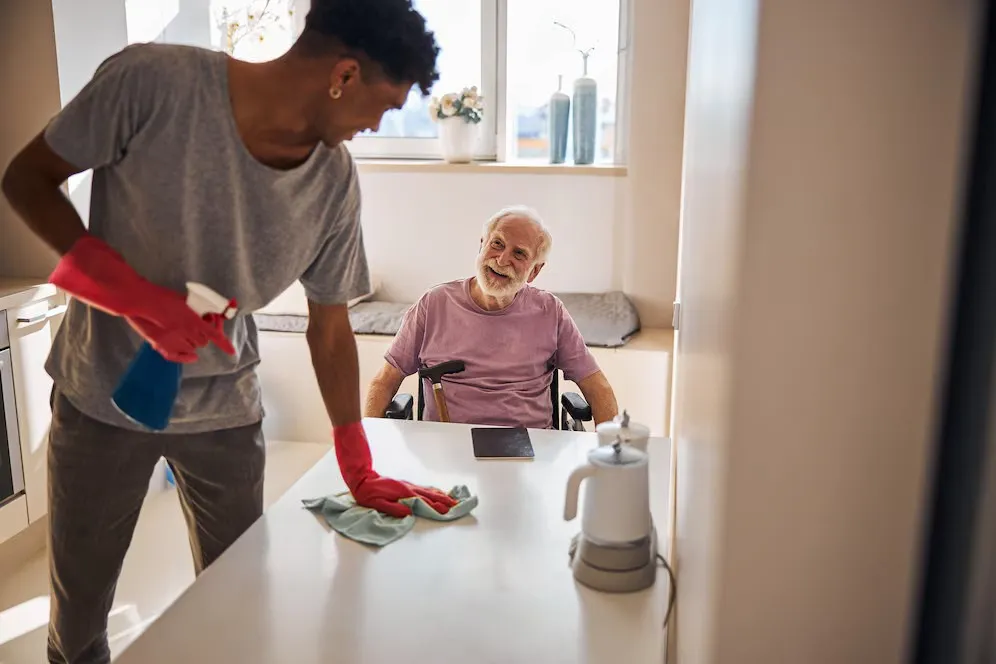Maintaining top-notch hygiene in senior care facilities isn’t just a requirement—it’s a responsibility. Seniors often have more vulnerable immune systems, and keeping their environment clean can make a huge difference in their health and well-being. Whether you’re running a facility or caring for a loved one, understanding these hygiene must-dos can help you create a safer, more comfortable living space.
Let’s walk through the top 10 hygiene essentials every senior care setting should prioritize.

1. Regular Deep Cleaning of Living Spaces
Daily cleaning is important, but it’s the deep cleaning that helps prevent the buildup of germs, bacteria, and allergens. Seniors often spend more time indoors, so it’s crucial their surroundings are spotless. Carpets can trap dust and allergens, while upholstery and curtains can harbor bacteria if not cleaned regularly.
Using professional cleaning services for seniors ensures these spaces are not only cleaned but sanitized with senior-friendly, non-toxic products. These teams know exactly how to approach the unique needs of older adults, ensuring their comfort and safety are always prioritized.
2. Disinfection of High-Touch Surfaces
Door handles, light switches, handrails, elevator buttons, and shared equipment are all touched constantly, making them prime areas for bacteria to spread. These high-touch points should be disinfected several times throughout the day, not just once.
Consider using hospital-grade disinfectants and scheduling disinfection rounds throughout the day. This is especially important during flu season or in times when there are higher risks of viral outbreaks. This simple step goes a long way in preventing infections and ensuring peace of mind for residents and their families.
- Hygiene Education for Staff and Residents
Proper hygiene isn’t just about cleaning—it’s also about knowledge. Everyone involved in a senior care facility, from caregivers to administrative staff to visitors, should be educated on proper hygiene practices.
This includes the correct way to wash hands, how to use personal protective equipment (PPE), and how to handle food safely. Having regular workshops or refresher training helps keep hygiene top-of-mind. It also fosters a culture of cleanliness and accountability, which benefits everyone.
4. Professional Laundry Protocols
Laundry might seem like a basic task, but in a senior care environment, it needs a professional touch. Clothes, bedding, towels, and cleaning rags must be washed frequently and at high temperatures to kill germs.
Proper sorting of laundry—separating soiled linens from clean ones and using color-coded bins—reduces the risk of cross-contamination. Professionals in housekeeping for senior living roles are trained to manage laundry efficiently and hygienically, keeping both the environment and residents safe.
5. Proper Waste Disposal Systems
Disposing of waste properly is a cornerstone of facility hygiene. This includes general waste, kitchen waste, and biohazard or medical waste. Overflowing bins or improper disposal can quickly lead to unpleasant odors, pests, and serious health hazards.
Senior care facilities should have a well-structured waste management plan that includes frequent pickup, clearly marked bins, and separate disposal areas. Staff should be trained on how to safely handle and dispose of waste to avoid contamination or accidental exposure.
6. Safe and Clean Kitchen Practices
The kitchen is another area that demands high hygiene standards. It’s not just about keeping countertops clean—it’s also about food safety. Improper handling, storage, or preparation of food can lead to foodborne illnesses, which can be particularly dangerous for seniors.
Kitchens should be cleaned thoroughly at the beginning and end of each day, and staff should follow strict guidelines on glove use, temperature control, and food separation. Investing in routine inspections and maintenance also helps ensure nothing is overlooked. Bringing in cleaning services for seniors can add another layer of protection by providing trained sanitation professionals to deep clean kitchen and dining areas.
7. Bathroom Sanitation and Accessibility
Bathrooms are high-traffic areas that require frequent and thorough cleaning. Floors should be mopped several times a day, and toilets, sinks, and grab bars should be disinfected regularly.
In addition to cleanliness, bathroom safety is critical. Non-slip mats, grab bars, and accessible toilets help prevent falls and accidents. Routine checks are essential to make sure everything is functioning as it should.
Cleaning services for seniors often include deep bathroom sanitization routines that exceed standard commercial cleaning, addressing the specific risks seniors may face in these environments.
8. Ventilation and Air Quality Control
Clean air is just as important as clean surfaces. Poor air quality can aggravate respiratory issues and contribute to the spread of airborne viruses and bacteria.
Ensure your facility has good ventilation systems in place. Filters should be replaced regularly, and air ducts should be cleaned at least once a year. Consider using portable air purifiers in common areas, especially during flu season or in enclosed spaces.
Bringing nature indoors—like plants that help purify air—can also contribute to healthier air while making the space feel more inviting.
9. Personal Hygiene Support for Residents
Supporting seniors with their daily hygiene routines is an essential part of care. As we age, tasks like bathing, brushing hair and teeth, and grooming can become more challenging. But maintaining these routines is crucial for both health and dignity.
Caregivers should be respectful and patient when assisting with personal hygiene. Creating a schedule helps maintain consistency, and offering choices—like preferred shampoos or lotions—can make the experience more comfortable.
Many housekeeping for senior living providers include personal hygiene assistance as part of their services, ensuring every resident receives the care and attention they need.
10. Scheduled Inspections and Hygiene Audits
Even the best cleaning routines can fall short without regular checks. Inspections and audits help ensure that hygiene standards are maintained consistently across the facility.
Create checklists for daily, weekly, and monthly cleaning tasks. Assign responsibilities and keep logs to ensure accountability. Bringing in third-party auditors or hygiene consultants a few times a year can provide fresh perspectives and identify gaps you might not notice otherwise.
These audits also reassure families that their loved ones are living in a safe and well-managed environment.
Conclusion
Creating a clean, healthy environment in senior care isn’t a one-time job—it’s a continuous commitment that involves everyone, from staff and caregivers to residents and their families. A well-maintained environment not only protects physical health but also contributes to emotional comfort and peace of mind.
By staying on top of deep cleaning, maintaining good air quality, ensuring proper food and bathroom sanitation, and supporting residents’ personal hygiene, you create a place where seniors can thrive.
Outsourcing to professionals who specialize in housekeeping for senior living or hiring cleaning services for seniors can take the pressure off internal staff and bring in expertise that ensures nothing gets overlooked. After all, in a space where health and comfort are everything, hygiene should always come first.
A clean space isn’t just about appearances—it’s about showing care, respect, and responsibility to those who deserve it most.





